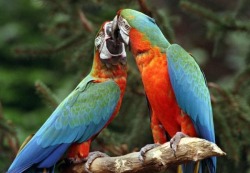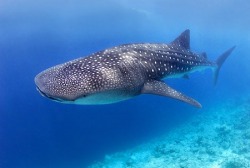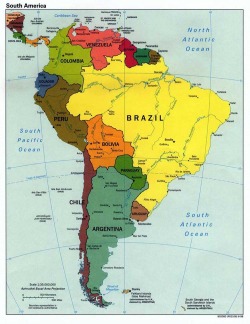South America

In the topic of illegal trade of wildlife animals in South America, we see that many of the species that are being smuggled to other countries are generally the critically endangered species. The species such as the Titi monkey, Scarlet Macaw, Golden Marmoset and the Hyacinth Macaw are just some of the endangered species being trafficked into other countries for their big profit in the black market. This kind of wildlife traffic in South America is very well known around the world and the issue has created awareness in the environmental community, but nevertheless in South America, the respective governments show from little to no interest in this kind of illegal trade.
Almost every country in South America had joined the CITES database by the year 1987 to protect and take initiative in their countries about the care of endangered species; this efforts have managed to save the biodiversity in many regions of South America, specially the Amazon. However, all this has been undermined in their neglect to reinforce their national airports security, since it is through these airports that the animals they have saved are now being sent to foreign countries, with different kinds of habitats, for selling.
Almost every country in South America had joined the CITES database by the year 1987 to protect and take initiative in their countries about the care of endangered species; this efforts have managed to save the biodiversity in many regions of South America, specially the Amazon. However, all this has been undermined in their neglect to reinforce their national airports security, since it is through these airports that the animals they have saved are now being sent to foreign countries, with different kinds of habitats, for selling.

Peru is one of the biggest exporters of illegal wildlife and bird species over the world, having low security and very few laws in the marketing of endangered animals; we can see things like street markets out on the open, selling this kind of rare Macaws (sought out for their feathers and for domestication), Tasmanian Devils, Bull monkeys and Pythons at very low prices. The market in Peru for rare animals is the largest, but not the only one in all South America.
Some of these countries, like Bolivia, had in their local markets “nearly 7,300 individuals of 31 parrot species, of which four were threatened species” . This just comes to show that even though threatened species are being protected in their habitat, the traffic of this species has not yet made the government aware of its unfairness.
Colombia
The international trade of endangered wildlife in Colombia includes species like the Titi Monkey, several kinds of Macaws, Flamencos and Iguanas. The Iguana, an exotic lizard of the Caribbean, is sold for its skin, but given that the Iguana is very hard to get on a plane unnoticed, the Iguana egg trafficking is the most profitable way of getting it into other nations. This egg has an incredibly high demand all over the world, making Colombia earn in the year 98 over 1.800 million COL$ just in Iguana egg; the Macaw feather and live animal export made over 150 million US$ on government statistics.[1] According to the Colombian government, over 600 thousand wild animals are exported for trade and over 200 thousand of them are primates. Despite the fact that Colombia has a very high rate in animal trafficking, several entities in Colombia are making an effort to improve their security on this topic. The City of Medellin, for example, has launched a campaign that states “Don’t buy, don’t sell and don’t have any natural fauna or flora in your possession”, and it has been a success in this city. The Ecological and Environmental police has stated that near 388.000 animals in captivity have been captured in the year 2007, and the national entity CARDER (pioneers in this security of animals’ issue) has managed to make the animal possession in Colombia illegal. But the battle is difficult, since in Colombia the custom has became over the years to have animals like Iguanas and Parrots.
Nevertheless the national government has set more importance on the civil war and drug trafficking going on in Colombia, not realizing that this kind of trafficking has become as profitable as drugs, given the prices of the trade in which a Peruvian parrot can cost 10 dollars in Peru and then in New York it can have a cost of about 3,000 dollars. According to the National Society of Protection of Animals, when the famous Colombian mafia leader Pablo Escobar was captured, his private zoo had over 2,000 animals of 100 different species, which constitutes the largest animal collection in all America
http://www.cites.org/eng/disc/parties/chronolo.shtml
http://www.birdlife.org/news/news/2007/12/bolivia_trade.html
http://www.scielo.unal.edu.co/scielo.php?pid=S0120-35842007000200003&script=sci_arttext&tlng=pt
Nevertheless the national government has set more importance on the civil war and drug trafficking going on in Colombia, not realizing that this kind of trafficking has become as profitable as drugs, given the prices of the trade in which a Peruvian parrot can cost 10 dollars in Peru and then in New York it can have a cost of about 3,000 dollars. According to the National Society of Protection of Animals, when the famous Colombian mafia leader Pablo Escobar was captured, his private zoo had over 2,000 animals of 100 different species, which constitutes the largest animal collection in all America
http://www.cites.org/eng/disc/parties/chronolo.shtml
http://www.birdlife.org/news/news/2007/12/bolivia_trade.html
http://www.scielo.unal.edu.co/scielo.php?pid=S0120-35842007000200003&script=sci_arttext&tlng=pt
Ecuador

Shark
Is one of the richest countries in biodiversity of the entire world, its biggest ecologic treasures are found in the Amazon and Galapagos islands. Those places are the principal areas where the animal hunters go to capture the animals that they need. This helps to unfold the destruction of those delicate and unique ecosystems. Since it is a small country (256.370 km^2), it is more vulnerable, because dealers can get out of the country with the species much easier. There is not strong security, so it is pretty much serious than the problem of Colombia or Brazil, even if those are bigger countries and richest in biodiversity.
There is another important fact, and is that “22.3% of Ecuador’s species are endemic”, you cannot find them in a different place.
The most trafficked species are: monkeys, exotic parrots, macaws, snakes, parakeets, sharks and the sea cucumber.
“In 2003, 5343 shark fins were took by the police, those fins belonged to about 235000 sharks, and 23.846 sea cucumbers were also took," a product very appreciated in Asia for their supposed aphrodisiac effects, according to state statistics Galapagos National Park (GNP) .” A shark´s fin can cost 100 dollars, and a sea cucumber can cost 16 dollars in the local trade, but statistics say that in the international market the prices can increase about a 500%. Outside the country, the prices are extremely expensive, 2000 dollars, 500 dollars, 5000 dollars etc. To make the business more productive, the dealers only pay 20 dollars to the animal catchers. They export firstly to these places: Spain, Asia and U.S.A, the principal dealers of exotic species.
There is another important fact, and is that “22.3% of Ecuador’s species are endemic”, you cannot find them in a different place.
The most trafficked species are: monkeys, exotic parrots, macaws, snakes, parakeets, sharks and the sea cucumber.
“In 2003, 5343 shark fins were took by the police, those fins belonged to about 235000 sharks, and 23.846 sea cucumbers were also took," a product very appreciated in Asia for their supposed aphrodisiac effects, according to state statistics Galapagos National Park (GNP) .” A shark´s fin can cost 100 dollars, and a sea cucumber can cost 16 dollars in the local trade, but statistics say that in the international market the prices can increase about a 500%. Outside the country, the prices are extremely expensive, 2000 dollars, 500 dollars, 5000 dollars etc. To make the business more productive, the dealers only pay 20 dollars to the animal catchers. They export firstly to these places: Spain, Asia and U.S.A, the principal dealers of exotic species.
http://www.youtube.com/v/kpcDNGGhmTU
Bibliography :
http://www.mascotas.org/wp-content/uploads/loros.jpg
http://como_una_centinela.ilcannocchiale.it/mediamanager/sys.user/17197/paisaje-colombiano.jpg
http://www.rau.edu.uy/universidad/iaeste/extranjeros/reception_booklet/images/south_america_pol98.jpg
http://animalmascota.com/wp-content/2009/10/iguana.jpg
http://www.eltiempo.com/verde/el-trafico-ilegal-de-especies-una-problematica-en-aumento-durante-el-2008-analisis_4615962
http://www.boletindenewyork.com/traficoanimales.htm
http://images.travelpod.com/users/pekingeend/1.1213363500.pto-lopez---whale-shark-jpghttp://www.actuaeselmomento.com/2009/09/el-trafico-de-especies-un-negocio.htmlwww.proteccionanimalvargas.com
www.animalesextincion.es/images/noticias/1911081214_nutria_gigante10.jpg
Group Members: Margarita Zuluaga, Maria Jose L, Alejandra Zuluaga 12°
Editor: Maria Andrea Ramirez

